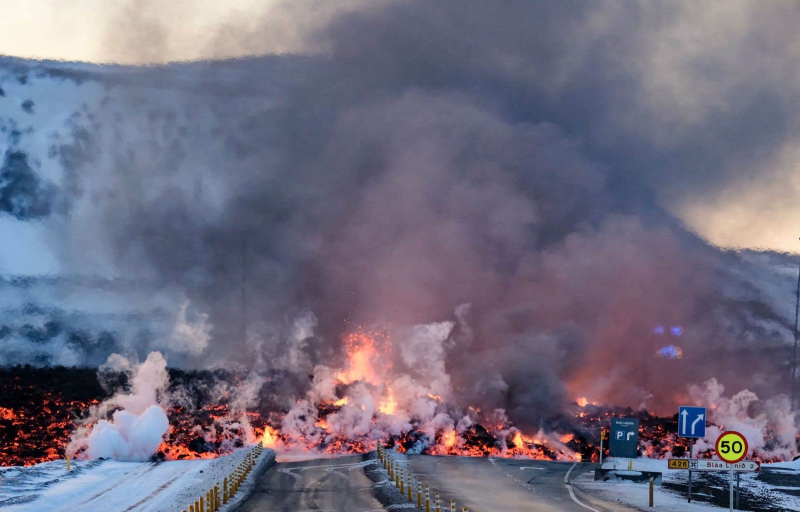
Photo: Kristinn Magnusson Agence France-Presse Molten lava overflows the road leading to the famous tourist destination “Blue Lagoon” near Grindavik.
Daniel Lawler – Agence France-Presse in and Paris
2:46 p.m.
- Europe
A new volcanic eruption hits the Reykjanes peninsula in southwest Iceland on Thursday, the third since December 18, with the alert level raised due to a risk of rupture of a major water pipe.
Since early Thursday morning, orange-red lava flows accompanied by a cloud of smoke have risen from a fissure approximately 3 km long, visible from the capital Reykjavik.
Civil Protection declared a state of emergency early in the afternoon after the lava flow covered and exploded a pipeline supplying hot water to the Reykjanes peninsula.< /p>
“The hot water main is broken, causing a shortage of hot water in Sudurnes. It is important that residents and businesses in Sudurnes save electricity and hot water”, indicates Civil Protection in a press release.
Some 28,000 people live in this region, located in the south of the peninsula, one of the most populated in Iceland, and whose electricity and water supply comes from the Svartsengi geothermal power station.
“We are working on the next steps to ensure that people receive hot water,” Civil Protection spokesperson Hjördis Gudmundsdóttir previously told AFP.
According to the authorities, the hot water supply in this region now relies solely on water stored in reservoirs. These tanks usually last three to six hours, possibly six to 12 hours if cost-saving measures are taken.
The eruption occurred about 40 km southwest of Reykjavik, in the same area as the previous ones that occurred on December 18 and January 14 near the town of Grindavik, whose 4,000 inhabitants were evacuated on November 11.
“At 5:30 a.m. (12:30 a.m. in Quebec) this morning, a small earthquake began to intensify northeast of Sýlingarfell. About 30 minutes later, an eruption started in the same area,” said the Icelandic Meteorological Office (IMO), which had been expecting an imminent eruption in recent days.
At the start of the morning, the lava jets reached a height of around 50 to 80 m and the plume rose to a height of around 3 km, the office continues.
This is the sixth volcanic eruption in Iceland in almost three years, the previous one having occurred in the early morning of January 14 already near Grindavik.
Also read
- Iceland's most active volcano under surveillance
- The eruption in Iceland extends further with a third volcanic fault
Protection dykes
This volcanic eruption is taking place about 5 km north of Grindavik, a town of nearly 4,000 inhabitants evacuated in November, said the spokesperson for Icelandic Civil Protection.
The Svartsengi power plant was previously evacuated and has been operating remotely since the December 18 eruption. Dikes were built to protect it.
They “are 8 to 10 meters high and are made of earth. They surround the entire power plant,” explained Ms. Gudmundsdóttir.
For their part, guests of the Blue Lagoon geothermal spa, a popular tourist destination, were safely evacuated, its management told Ruv.
“The situation is under control, there is no danger. The airport is safe. People are 100% safe,” the Icelandic civil protection spokesperson reassured.
Until the March 2021 eruption, the Reykjanes Peninsula, south of the capital Reykjavik, had been spared from eruptions for eight centuries.
There have been five others since, in August 2022 and July 2023, December 18, 2023, January 14 and this Thursday, a sign, for volcanologists, of a resumption of volcanic activity in the region.
The small town of Grindavik was damaged in November by a series of eruption-precursor earthquakes that opened large cracks in the ground and on some buildings. During the January 14 eruption, three houses were burned by lava, something unprecedented in 51 years in the country.
Thirty-three volcanic systems are considered active in this country of fire and ice, the most volcanic region in Europe.
Record magma flow
The magma river that erupted from a fault in the ground near the Icelandic town of Grindavik last November recorded a record flow rate, according to a study published in Science on Thursday.
On November 10, in just six hours, a surge of magma formed a fissure, called a dyke, 15 km long and 4 km deep and only a few meters wide.
The magma flowed out at a rate of 7,400 m3 per second, “at a rate never before recorded” in Iceland or elsewhere, Freysteinn Sigmundsson, a researcher at the Center for Nordic Volcanology at the University of Iceland, told AFP. Iceland and first author of the study.
By comparison, the average flow of the Seine is just 560 m3 per second. That of the Grindavik magma river was closer to that of very large rivers like the Danube in Europe or the Yukon in Alaska. And the total amount of magma that flowed in November was 100 times greater than those from 2021 to 2023 eruptions across the country, according to Freysteinn Sigmundsson. It’s a sign that “activity is accelerating,” he summarizes. The November eruption paved the way for other serious eruptions in December and then in January.
The increasing pressure from the underground magma pocket has caused hundreds of surface tremors and a rise in the ground of a few millimeters per day, creating numerous crevasses and damage to infrastructure in and around Grindavik. Even more dangerous than lava magma: the presence of hidden crevasses, according to Mr. Sigmundsson, who reports the discovery this week of one of its crevasses in the middle of a sports field. The most difficult part remains forecasting underground activity, which is uncertain at least for several months.
